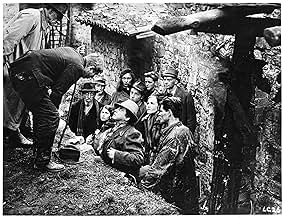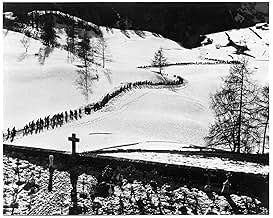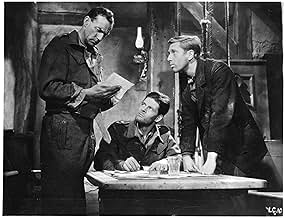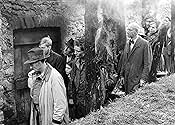IMDb RATING
6.5/10
545
YOUR RATING
Escaping a Nazi prison train in war-torn Italy, an American and a British soldier set out for the Swiss border and find themselves leading a multi-national party of refugees for the Italian ... Read allEscaping a Nazi prison train in war-torn Italy, an American and a British soldier set out for the Swiss border and find themselves leading a multi-national party of refugees for the Italian underground.Escaping a Nazi prison train in war-torn Italy, an American and a British soldier set out for the Swiss border and find themselves leading a multi-national party of refugees for the Italian underground.
- Awards
- 4 wins total
Maurice Sakhnowsky
- Hillel Sokolowski
- (as M. Sakhnowsky)
Featured reviews
This is a wonderful movie. The copy I saw was not good, but that did not detract from the emotional and realistic story. It provides, as much as anything can, what seems to be a legitimate sense of the desperation that these refugees must have felt as they were driven from their homes by the war around them. Exceptional story in a raw but effective production.
In the chaos surrounding the Italian campaign, an American flier and a British officer meet after having escaped internment. They make their way north towards Switzerland. They are aided by ordinary people. When news comes that Mussolini has escaped the partisans, a local Fascist rats them out to the Germans and they have to make a run for it over the wintry mountains, leading a desperate band of refugees.
This Swiss movie was directed and co-written by Leopold Lindtberg. He knew something about being a refugee. He began his career in the theater and the movies in his native Vienna, but in the early 1940s, his Jewish religion forced him to flee to Switzerland. By chance he was able to cast this movie well: two of the "escaped British officers" were precisely that, and professional actors to boot; the American was a flier whose plane came down in Switzerland, and was being held there until matters could be sorted out.
Although there are dramatic, theatrical moments, the setting in the mountains and towns of Switzerland, and the casting of locals lends a humanist air to the movie that made me think of Pressberger & Powell's movies of the period. the camerawork is extraordinary; instead of using rapid cutting to create excitement, cinematographer Emil Berna uses a moving camera, with fast, long movements to produce a sense of panic.
Although this sort of movie was almost a commonplace of the era, it's ANABASIS-like plot of trying to escape -- only this time, it's to Switzerland, instead of the sea -- and its fortuitous casting makes it extraordinary.
This Swiss movie was directed and co-written by Leopold Lindtberg. He knew something about being a refugee. He began his career in the theater and the movies in his native Vienna, but in the early 1940s, his Jewish religion forced him to flee to Switzerland. By chance he was able to cast this movie well: two of the "escaped British officers" were precisely that, and professional actors to boot; the American was a flier whose plane came down in Switzerland, and was being held there until matters could be sorted out.
Although there are dramatic, theatrical moments, the setting in the mountains and towns of Switzerland, and the casting of locals lends a humanist air to the movie that made me think of Pressberger & Powell's movies of the period. the camerawork is extraordinary; instead of using rapid cutting to create excitement, cinematographer Emil Berna uses a moving camera, with fast, long movements to produce a sense of panic.
Although this sort of movie was almost a commonplace of the era, it's ANABASIS-like plot of trying to escape -- only this time, it's to Switzerland, instead of the sea -- and its fortuitous casting makes it extraordinary.
"The Last Chance" is a movie about escape and pursuit. It is about Italian villagers helping Jews and Allied POWs escape; and about the Allies helping the Jews as well. The setting for the film was 1943, and the place was northern Italy. This little known film was made in Switzerland and released in Zurich, on May 26, 1945 -- less than three weeks after the end of WWII in Europe. It opened later that year in New York City (Nov. 27), in Brussels (Dec.2), and in Paris (Dec. 19). It appeared in most other European countries in 1946 – but wasn't shown in Italy or Austria until 1947. It was distributed by MGM.
Most of the cast were unknown outside of Europe. The main supporting actors had much more movie experience than any of the three male leads who played the Allied soldiers fleeing the Nazis. Ewart Morris appeared in only one other movie, and John Hoy and Ray Reagan appeared only in this film. Even with their inexperience, the three leads were very good. Characters in the film speak four languages – Italian, English, German and French.
The quality of the film I have is very poor. The movie was obviously made on the cheap, but it is very well done and is an excellent story. Very little costuming or casting was needed of German soldiers. Instead, much of the filming was done of the escapees and villagers helping them. Excellent filming techniques were used. The use of key lighting with lots of shadows reminds one of the early styles used by Alfred Hitchcock and John Ford.
The movie most likely was filmed in Switzerland and part of Italy around Lake Maggiore. This 52,500-acre lake (23,870 hectares) straddles the border of Italy and Switzerland. It was a route frequently used by escaping POWs and downed Allied pilots. Other war movies have been made with escapes by way of Lake Maggiore. At the time of filming, director Leopold Lindtberg would have had no difficulty finding a burned or war- damaged Italian villages in the area. Many locals would be able to serve as extras for the townspeople in the film. These were people who had lived through such treachery and horror within just the past year or two. The film won the grand prize at the Cannes Film Festival in 1946, and earned a Golden Globe in 1947.
"The Last Chance" is a very good war drama from WWII. At the start of the war, Italy was a fascist state and ally of Germany. But the people overthrew Benito Mussolini in 1943. And, throughout the war, Italians aided Jews fleeing the Nazis. They hid and helped American, British and other Allied downed pilots; and they helped escaping POWs. Thousands of Italians were killed by the Germans for aiding escaping Allied soldiers. No other nation during WWII did more to help those fleeing the Nazis. This is a fine movie about that time and effort.
Most of the cast were unknown outside of Europe. The main supporting actors had much more movie experience than any of the three male leads who played the Allied soldiers fleeing the Nazis. Ewart Morris appeared in only one other movie, and John Hoy and Ray Reagan appeared only in this film. Even with their inexperience, the three leads were very good. Characters in the film speak four languages – Italian, English, German and French.
The quality of the film I have is very poor. The movie was obviously made on the cheap, but it is very well done and is an excellent story. Very little costuming or casting was needed of German soldiers. Instead, much of the filming was done of the escapees and villagers helping them. Excellent filming techniques were used. The use of key lighting with lots of shadows reminds one of the early styles used by Alfred Hitchcock and John Ford.
The movie most likely was filmed in Switzerland and part of Italy around Lake Maggiore. This 52,500-acre lake (23,870 hectares) straddles the border of Italy and Switzerland. It was a route frequently used by escaping POWs and downed Allied pilots. Other war movies have been made with escapes by way of Lake Maggiore. At the time of filming, director Leopold Lindtberg would have had no difficulty finding a burned or war- damaged Italian villages in the area. Many locals would be able to serve as extras for the townspeople in the film. These were people who had lived through such treachery and horror within just the past year or two. The film won the grand prize at the Cannes Film Festival in 1946, and earned a Golden Globe in 1947.
"The Last Chance" is a very good war drama from WWII. At the start of the war, Italy was a fascist state and ally of Germany. But the people overthrew Benito Mussolini in 1943. And, throughout the war, Italians aided Jews fleeing the Nazis. They hid and helped American, British and other Allied downed pilots; and they helped escaping POWs. Thousands of Italians were killed by the Germans for aiding escaping Allied soldiers. No other nation during WWII did more to help those fleeing the Nazis. This is a fine movie about that time and effort.
The Last Chance - Swiss Film - 1945
I first watched this film on BBC Television when I was about 11 years old in 1962.
I remember thinking about how realistic it was, leaving nothing out of place as a good film production. On IMDB, I notice that no "goofs", anachronisms, or continuity flaws are listed. That is because there weren't any.
What inspired me about the films authenticity, was how the escaped prisoners of war overcame the language difficulty - one of the men had a working knowledge of the Italian language that he would have picked up as a prisoner of war.
Language problems are always something that more commercial War films often seem to short cut - as if the film audience is supposed to believe that everyone in Europe speaks English.
I searched for years to see if I could find any reference to this film and eventually found it in a copy of Leslie Halliwell's Film Goers Companion. The advent of the Internet allowed me to watch the film again on YouTube.
What is also quite unusual about the film is that the leading roles are played by actors who, themselves, had served in the Second World War, had been captured, and had escaped to Switzerland - very brave men.
It is also interesting that the supporting cast consisted of many well-known European actors and actresses. Performers such as Luisa Rossi and Therese Giehse were very famous at the time. The latter was once described as the greatest actress in Europe.
It is surprising that I have never seen the film shown again on the television since 1962.
The film has many poignant moments, which adds to the whole defined aura of the film.
The Last Chance neither glamorises, nor comes over as an anti-war film, but serves as a reverent tribute to the brave men and women who served in such a conflict where so many people suffered and died.
I give it 10 out of 10.
I first watched this film on BBC Television when I was about 11 years old in 1962.
I remember thinking about how realistic it was, leaving nothing out of place as a good film production. On IMDB, I notice that no "goofs", anachronisms, or continuity flaws are listed. That is because there weren't any.
What inspired me about the films authenticity, was how the escaped prisoners of war overcame the language difficulty - one of the men had a working knowledge of the Italian language that he would have picked up as a prisoner of war.
Language problems are always something that more commercial War films often seem to short cut - as if the film audience is supposed to believe that everyone in Europe speaks English.
I searched for years to see if I could find any reference to this film and eventually found it in a copy of Leslie Halliwell's Film Goers Companion. The advent of the Internet allowed me to watch the film again on YouTube.
What is also quite unusual about the film is that the leading roles are played by actors who, themselves, had served in the Second World War, had been captured, and had escaped to Switzerland - very brave men.
It is also interesting that the supporting cast consisted of many well-known European actors and actresses. Performers such as Luisa Rossi and Therese Giehse were very famous at the time. The latter was once described as the greatest actress in Europe.
It is surprising that I have never seen the film shown again on the television since 1962.
The film has many poignant moments, which adds to the whole defined aura of the film.
The Last Chance neither glamorises, nor comes over as an anti-war film, but serves as a reverent tribute to the brave men and women who served in such a conflict where so many people suffered and died.
I give it 10 out of 10.
This film tells the story of a troupe of escaped prisoners and persecuted minorities on the run in Italy during WW2 trying to make it to freedom in Switzerland. The location setting stands this film apart as well as the fact that we never see a German Nazi's face. They are only seen from a distance or passing by outside. We do get betrayal within a group of villagers, a priest who shelters refugees, and an escape plan that has to constantly change. Ultimately, the film is predictable and some characters can be annoying. Something else to consider is that the 3 main characters were all real-life soldiers who had ended up in Switzerland. Two of them were prisoners of war who had escaped from Italy and 1 had to make an emergency landing after a bombing mission and was detained there. It is this fact that swung the balance in favour of keeping onto this film to view again as we get a slice of reality. Unfortunately, the sound quality is poor.
It's always interesting to learn something new about WW2 and I never knew the role of the Italian Resistance on their home turf. So, I appreciate the topic.
It's always interesting to learn something new about WW2 and I never knew the role of the Italian Resistance on their home turf. So, I appreciate the topic.
Did you know
- TriviaThe three leads were all real prisoners of war who had escaped to Switzerland, and were asked by the director Leopold Lindtberg to be in the film. Ewart G. Morrison (Maj. Telford) even wore the clothes he had escaped in as his costume.
- SoundtracksFrère Jacques
Traditional
Sung by the party in the mountain hut
Details
- Release date
- Country of origin
- Official site
- Languages
- Also known as
- Dernière chance
- Filming locations
- Production company
- See more company credits at IMDbPro
- Runtime1 hour 53 minutes
- Color
- Sound mix
- Aspect ratio
- 1.37 : 1
Contribute to this page
Suggest an edit or add missing content



























